How to Cite | Publication History | PlumX Article Matrix
V. Sridevi* and M. V. V. Chandana Lakshmi
Department of Chemical Engineering (Biotechnology), Andhra University, Visakhapatnam - 03 India.
Corresponding Author E-mail: vellurusridevi@yahoo.co.in
ABSTRACT: Phenol is a reasonably common wastewater contaminant, which has been found to be either toxic or lethal to fish, and most types of organisms at relatively low concentrations. Studies on microbial means of treating or removing phenols date back to atleast three decades. It was found that degrading potential of Pseudomonas sp., was strongly affected by the variations in pH, temperature, inoculum size. The purpose of this investigation was to study the effect of inoculum size and the influence of pH on phenol degradation by Pseudomonas aeruginosa (NCIM 2074) and Pseudomonas desmolyticum (NCIM 2028) in batch reactor and their comparison. The maximum process conditions for maximizing phenol degradation (removal) were recognized as follows -P. aeruginosa: pH 7, inoculum size 5% v/v and P. desmolyticum : pH 6, inoculum size 4% v/v. P. aeruginosa had better degradation rate than P. desmolyticum. P. aeruginosa at the optimum conditions (pH 7, 5% v/v) degraded 1000 mg/l of phenol concentration and P. desmolyticum at the optimum conditions (pH 6, 4% v/v) could not tolerate 1000 mg/l of phenol concentration and could degrade upto 700 mg/l. Hence, maximum removal efficiency of phenol was achieved at the optimum process conditions by P. aeruginosa (pH 7, 5% v/v).
KEYWORDS: Phenol; Biodegradation; Pseudomonas aeruginosa; P; desmolyticum; pH; Inoculum size
Download this article as:| Copy the following to cite this article: Sridevi. V, Lakshmi. M. V. V. C. A Comparative and Optimization Study on Phenol Degradation by Pseudomonas Aeruginosa (NCIM 2074) and Pseudomonas Desmolyticum (NCIM 2028). Biosci Biotechnol Res Asia 2009;6(2) |
| Copy the following to cite this URL: Sridevi. V, Lakshmi. M. V. V. C. A Comparative and Optimization Study on Phenol Degradation by Pseudomonas Aeruginosa (NCIM 2074) and Pseudomonas Desmolyticum (NCIM 2028). Biosci Biotechnol Res Asia 2009;6(2). Available from: https://www.biotech-asia.org/?p=8744. |
Introduction
Environmental pollution has been considered as a side effect of industrial society. Soil, lakes, rivers and seas are highly contaminated with different toxic compounds (Alexander, 1981). An example of such compound is phenol. Phenol is released into the environment from industrial discharges (Keith, 1976, Jungclaus et al, 1978, Parkhurst et al, 1979, Pfeffer, 1979) and spills (Delfino and Dube, 1976). According to Prasad and Ellis (1978), phenols and its derivatives are among the most frequently found pollutants in rivers, industrial effluents and landfill run-off waters. Hence, populations residing near waste disposal sites, landfill sites or phenol spills may be at risk for higher exposure to phenol than other populations. The origin of phenol in the environment is both natural and industrial. Natural sources of phenol include forest fire, natural run off from urban area where asphalt is used as the binding material and natural decay of lignocellulosic material. Industrial sources such as oil refineries, chemical, petrochemical, pharmaceutical, metallurgical, pesticide products, paint and varnish industries, textile and also in the polymer industries like phenolic resins, bisphenol A, alkylphenols, caprolactums and adipic acid (Paula et al, 1998). Hence removal of phenol from industrial aqueous effluents is an important practical problem. Their presence in sewage and river water has also been confirmed (Thomas, 1973). Because of their high reliability and water solubility, phenols impart taste and odour problems to drinking water supplies even at parts per billion levels (Gosselin et al, 1984). Phenols are protoplasmic poisons, hence damage all kinds of cells. They are alleged to have caused an astonishing number of poisonings since they have come into general use. Fatal doses of phenols can be absorbed by the skin.
The removal of phenol from industrial effluents has attracted researchers from different fields (Yang and Humphrey, 1975, Shingler, 1996). The increasing awareness on the environment in both developed and developing countries has initiated more studies of possible solutions for treating phenol.
Environmental biotechnology relies on the pollutant – degrading capacities of naturally occurring microorganisms (Liu and Suflita, 1993). It has been reported to be advantageous over physical and chemical treatments due to its relatively low cost and has less ecological impact to the environment (Head, 1998, Edington, 1994). Researchers are studying pollutant-degrading microorganisms which inhabit polluted environments (Kumaran, 1980, Kapoor et al, 1998, Yap et al, 1999, Heinaru et al, 2000, Komarkova et al, 2003, Santos and Linardi, 2004, Margesin et al, 2005) as well as uncontaminated environment (Bastos et al, 2000a, Kounty et al, 2003). Harnessing the potential of microbes ( Ahmed, 1995, Fulthorpe and Allen, 1995, Bastos et al, 2000b, Ruiz-Ordaz et al, 2001, Vojta et al, 2002, Paca Jr. et al, 2003) to degrade phenol has been an area of considerable study to develop bioremediation approaches which has been considered as a “green-option “ ( Singleton, 1994) for treatment of environmental contaminants.
Many researchers support the biological treatment of phenols. A number of studies with prokaryotic microorganisms have been carried out for the purpose to improve the technological processes of biodegradation. Some examples are Pseudomonas sp., have demonstrated the ability to mineralize phenol ( Ehrhardt and Rehm, 1989, Hinteregger et al, 1992, Ahmed, 1995, Chitra et al,1995, Dapaah and Hill, 1992, Fulthorpe and Allen, 1995, Fava et al, 1995, Loh and Wang, 1998).The biodegradation of phenol by P. aeruginosa and P. desmolyticum, potential degradents of phenol have been investigated for its degrading potential under different operating conditions and were compared. Two variables of pH and inoculum size were used to identify the significant effects and interactions in the batch studied. Phenol degradation was studied by P. aeruginosa and P. desmolyticum with different phenol concentrations (500 mg/l, 700 mg/l, 900 mg/l and 1000 mg/l) at their optimized conditions. The maximum tolerance limit of phenol for P. aeruginosa and P. desmolyticum were also tested.
Materials and Methods
Chemicals
Phenol (99% pure, chemical grade) 4-amino antipyrine and all other chemicals used were from Merck.
Source of Organism
The microorganism P. aeruginosa (NCIM 2074) and P. desmolyticum (NCIM 2028) were obtained from culture collection (NCL) Pune, India. The microorganisms were maintained separately on a medium containing Beef extract: 1.0 g/l, Yeast extract: 2.0 g/l, Peptone: 5.0 g/l, NaCl: 5.0 g/l and Agar: 20 g/l. The pH of the medium was adjusted to 7.0 by adding 1N NaOH. It was stored at 320C for further use.
Growth determination
To study the extent of degradation, the cells were grown in a Minimal Salts (MS) medium with the following composition: Phenol 0.500 g/l; K2HPO4, 1.5 g/l; KH2PO4, 0.5 g/l; (NH4)2SO4, 0.5 g/l; NaCl, 0.5 g/l; Na2SO4, 3.0 g/l; Yeast extract, 2.0 g/l; Ferrous sulfate, 0.002 g/l; CaCl2, 0.002 g/l in conical flasks containing and inoculated with P. aeruginosa(NCIM 2074) and P.desmolyticum(NCIM 2028) individually. The experimental studies were carried out in shake flasks with agitation at a rate of 120 rpm, temperature at 320C. Bacterial growth was determined in terms of cell mass by measuring optical density at a wavelength of 500nm.
Influence of pH of the medium on phenol degradation
Pseudomonas Cells were grown in MS medium with 500 mg/l of phenol at different pH 5 to 9. This mixture was contained in 250 ml Erlenmeyer flasks. The cultures were placed on a shaker (120rpm) at 320C. At different times, growth and phenol degradation were measured.
Effect of inoculum size on phenol degradation
The effect of inoculum size (1 – 10% v/v) on phenol degradation was tested. Cells were grown as shake cultures at 320C in MS medium supplemented with 500mg/l phenol at pH 7 in case of P. aeruginosa and pH 6 for P. desmolyticum in 250 ml Erlenmeyer flask. At different times, growth and phenol degradation were measured.
Estimation of phenol
Phenol was determined quantitatively by the Spectrophotometric method (DR/ 4000 V, Hach) using 4-amino antipyrine as the color reagent (λ max: 500nm) according to standard methods of analysis (APHA, 1989).
Growth determination
Bacterial growth was determined in terms of cell mass by measuring optical density at a wavelength of 500nm.
Results and Discussions
aeruginosa (All the data is not plotted for clarity)
Influence of pH of the medium on phenol degradation
pH values from 5 to 9 were investigated (Fig. – 1). Phenol was degraded rapidly at pH 7. At this pH value, phenol degradation was high compared to other pH values. However, the phenol degradation at pH 5, 6, 8, and 9 was slower and phenol concentration decreased rapidly after 24 hrs inoculation. These results showed that P. aeruginosa degraded more phenol per day at pH 7 than at any other pH value.
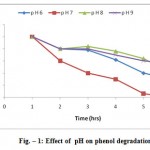 |
Figure 1: Effect of pH on phenol degradation.
|
Effect of inoculum size on phenol degradation
Phenol was degraded by P. aeruginosa during all the inoculum sizes (1-10% v/v) tested (Fig. – 2). At 5% v/v the phenol concentration began to decrease rapidly after 5 hrs and reached 5mg/l after approximately 70 hrs. Cultures inoculated with 5 % v/v inoculum size showed the highest rate of phenol degradation, while the cultures inoculated with the other inoculum sizes showed a decrease in phenol consumption.
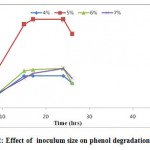 |
Figure 2: Effect of inoculum size on phenol degradation.
|
desmolyticum (All the data is not plotted for clarity)
Influence of pH of the medium on phenol degradation
pH values from 5 to 9 were examined (Fig. – 3). At pH 6 phenol concentration started decreasing after 24 hrs inoculation when compared to other pH values. These results showed that P.desmolyticum degraded more phenol per day at pH 6 than at any other pH values.
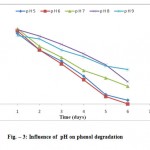 |
Figure 3: Influence of pH on phenol degradation.
|
Effect of inoculum size on phenol degradation
Phenol degradation by P. desmolyticum at inoculum sizes (1-10% v/v) was tested (Fig. – 4). The phenol degradation was optimized at 4% v/v and phenol concentration began to decrease rapidly after 5 hrs and reached 50 mg/l after approximately 70 hrs.
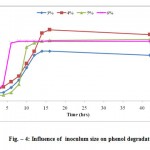 |
Figure 4: Influence of inoculum size on phenol degradation.
|
At these optimized values of P. aeruginosa (pH 7, 5%v/v) and P.desmolyticum (pH 6, 4% v/v), the phenol degradation was tested and compared. Fig. – 5, show the experimental variation of the phenol concentration with time. As can be seen, P. aeruginosa at its optimum conditions degraded 1000mg/l of phenol concentration and P. desmolyticum at its optimum conditions could not tolerate 1000 mg/l of phenol concentration and could degrade only upto 700 mg/l. Hence, maximum removal efficiency of phenol was achieved at the optimum process conditions by P. aeruginosa.
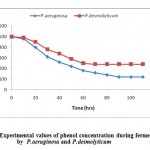 |
Figure 5: Experimental values of phenol concentration during fermentations by P.aeruginosa and P.desmolyticum.
|
References
- Alexander, M. Biodegradation of chemicals of environmental concern. Sci., 211: 132-138 (1981).
- Keith. L.H. Identification of organic compounds in unbleached treated Kraft paper mill waste waters. Environ. Sci. Technol., 10: 555-564 (1976).
- Jungclaus, G.A., Lopez- Avila, V., Hites, R.A. Organic compounds in industrial waste water. A case study on their environmental impact. Environ. Sci. Technol., 12: 88-96 (1978).
- Parkhurst, B.R., Bradshaw, A.S. and Forte, J.L. An evaluation of the acute toxicity to aquatic biota of a coal conversion effluent and its major components. Bull. Environ. Contam. Toxicol., 23: 349-356 (1979).
- Pfeffer, F.M. The 1977 screening survey for measurement of organic priority pollutants in petroleum refinery waste waters. ASTM Spec. Tech. Publ., 181-190 (1979).
- Delfino, J.J. and Dube, D.J. Persistent contamination of ground water by phenol. Environ. Sci. Health., A11 : 345-355 (1976).
- Prasad and Ellis, E. In vivo characterization of catechol ring cleavage in cell cultures of Glycine max. Phytochem., 17: 187-190 (1978).
- Paula, M., Van Schei. and Young, L.Y. Isolation and characterization of phenol degrading denitrifying bacteria. Appl. Environ. Microbiol., 64: 2432-2438 (1998).
- Thomas, N.A. Assesment of fish fleshtainting substances in biological methods for the assessment of water quality, ASTM. STP., 52B: 178-193 (1973).
- Gosselin, E., Smith, R.P. and Harold, C. Phenol: In clinical Toxicology of commercial products Williams and Wilkins, 5th edn. Baltimore, London, (1984).
- Yang, R.D. and Humphrey, A.E. Dynamics and steady state studies of phenol degradation in pure and mixed culture. Biotechnol Bioeng., 17: 1211-1235 (1975).
- Shingler, V. Molecular and regulatory checkpoints in phenol degradation in Pseudomonas sp. CP600. In: Nakazawa, T., Furukawa, K., Haas, D. and Silver, S. (eds.,) Molecular biology of Pseudomonas. Am. Soc. Microbiol., Washington, D.C. 153-164 (1996).
- Liu, T. and Suflita, J.M. Ecology and evolution of microbial populations for bioremediation. Trends Biotechnol., 11: (1993).
- Head , I.M. Bioremediation: toward a credible technology. Microbial., 144: 599-608 (1998).
- Edington, S.M.Environmental Biotechnology. Bio / Technol., 12: 1338-1342 (1994).
- Kumaran, P. Microbial degradation of phenol in phenol-bearing industrialwastes. Ph.D.Thesis, Nagpur, Univ., India (1980).
- Kapoor, A., Kumar, R., Kumar, A. and Prasad, S. Application of immobilized mixed bacterial cultrure for the degradation of phenol present in oil refining effluent. Environ. Sci. Health., 33(6): 1009-1021 (1998).
- Yap, L.F., Lee, Y.K. and Poh, C.L. Mechanism for phenol tolerance in phenol-degrading Comamonas testosteroni strain . Appl. Microbiol. Biotechnol., 5(6): 833-840 (1999).
- Heinaru, E., Truu, J., Stottmeister, U. and Heinaru, A. Three types of phenol and p-cresol catabolism in phenol –and –p-cresol-degrading bacteria isolated from river water continuously polluted with phenolic compounds. FEMS Microbiol. Ecol., 31 (3): 195-205 (2000).
- Komarkova, E., Paca, J., Klapkova, E., Stiborova, M., Soccol, C.R. and Sobotka, M. Physiological change changes of Candida tropicalis population degrading phenol in Fed batch reactor. Braz . Arch. Biol. Technol., 46(4): 537-543 (2003).
- Santos, V.L. and Linardi, V.R. Biodegradation of phenol by a filamentous fungi isolated from industrial effluents-identification and degradation potential. Proc. Biochem., 39: 1001-1006 (2004).
- Margesin, R., Fonteyene, P.A. and Redl, B. Low-temperature biodegradation of high amounts of phenol by Rhodococcus sp., and basidiomycetous yeasts. Res. Microbiol., 156: 68-75 (2005).
- Bastos, A.E.R., Tornisielo, V.L., Nozawa, S.R., Trevors, J.T. and Rossi, A. Phenol metabolism by two microorganisms isolated from Amazonian forest soil samples. Ind . Microbiol. Biotechnol., 24(6): 403-409 (2000a).
- Kounty, M., Ruzicka, J. and Chlachula, J. Screening for phenol-degrading bacteria in the pristine soils of south Siberia. Appl. Soil. Ecol., 23(1): 79-83 (2003).
- Ahmed, A.M. Phenol degradation by Pseudomonas aeruginosa. Environ .Sci. Health, 30: 99-103 (1995).
- Fulthorpe, R.R and Allen, D.G. A comparison of organochlorine removal from bleached Kraft pulp and paper-mill effluents by dehalogenating Pseudomonas, Ancylobacter and Methylobacterium strains. Appl. Microbiol. Biotechnol., 42: 782-787 (1995).
- Bastos, A.E.R., Moon, D.H., Rossi, A., Trevors, J.T. and Tsai, S.M. Salt tolerant phenol-degrading microorganisms isolated from Amazon soil samples. Arch. Microbiol., 174: 346-352 (2000b).
- Ruiz- Ordaz, N., Ruiz- Lagunez, J.C., Castanon- Gonzalez, J.H., Hernandez- Manzano, E., Christiani- Urbina, E. and Galindez- Mayer, J. Phenol biodegradation using repeated batch culture of Candida tropicalis in a multistage bubble column. Revista Latinomericana de Microbioligia., 43: 19-25 (2001).
- Vojta, V., Nahlik, J., Paca, J and Komarmova, E. Development and verification of the control system for fed-batch phenol degradation process. Chem. Biochem, Eng., 16(2): 59-67 (2002).
- Paca Jr., J., Sucha, V., Miksanova, M. Enzymes of yeast Candida tropicalis responsible for the first step of phenol degradation . Abstract – Poster presentation at XXII. Xenobiochemicke Sympozim Smolence 9. Prague, Czech Republic. 9-11 June, 31-31 (2003).
- Singleton, I. Microbial metabolism of xenobiotics: fundamental and applied research. Chem. Technol. Biotechnol., 59: 9-23(1994).
- Ehrhardt, H.M. and Rehm, H.J. Semicontinuous and continuation degradation of phenol by Pseudomonas putida P8 absorbed on activated carbon. Appl. Microbial. Biotechnol., 30 : 312-317 (1989).
- Hinteregger, C., Leitner, R., Loidl, M., Ferschl., A. and Streichsbier , F. Degradation of phenol and phenolic compounds by Pseudomonas putida EKII. Appl. Microbial. Biotechnol., 37: 252-259 (1992).
- Chitra, S., Sekaran, G., Padmavathi, S. and Chandrakasan, G. Removal of phenolic compounds from waste water using mutant strain of Pseudomonas pictorum. Gen. Appl. Microbial., 41: 229-237 (1995).
- Dapaah, S.Y. and Hill, G.A. Biodegradation of chlorophenol mixtures by Pseudomonas putida. Biotechnol. Bioeng., 40: 1353-1358 (1992).
- Fava, F., Armenante, P.M. and Kafkewitz, D. Aerobic degradation and dechlorination of 2-chlorophenol and 4- chlorophenol by Pseudomonas pickettii strain. Appl. Microbial. Lett., 21: 307-312 (1995).
- Loh, K.C. and Wang, S.J. Enhancement of biodegradation of phenol and non-growth substrate 4-chlorophenol by medium augmentation with conventional carbon source. Biodegr., 8: 329-338 (1998).
- American Public Health Association (APHA), American Water Works Association, Water Pollution Control Federation. Standard methods for the examination of water and wastewater. 17th edition. Washington, D.C. American Public Health Association. 9-55 – 9-62 (1989).

This work is licensed under a Creative Commons Attribution 4.0 International License.





